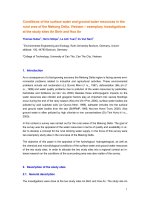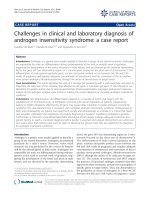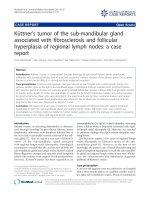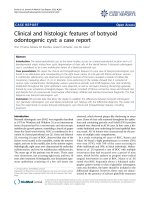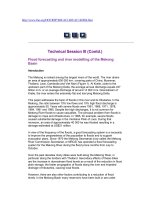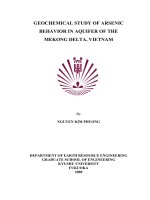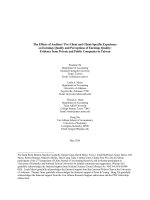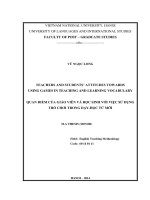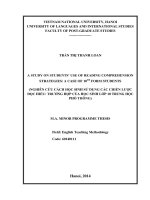Teachers and students perceptions of the alignment in a general english curriculum a case in the mekong delta (tt)
Bạn đang xem bản rút gọn của tài liệu. Xem và tải ngay bản đầy đủ của tài liệu tại đây (1.59 MB, 16 trang )
ABSTRACT
Constructive alignment in a curriculum has been mentioned by many
previous experts all over the world. This study partly contributed in this area. This
research was conducted to investigate the teachers and students’ perceptions of the
alignment in a General English curriculum in the context of a university in the
Mekong Delta, Vietnam. Participants of this study were sixteen teachers and one
hundred and sixty- seven students in a university in the south of Vietnam.
Qualitative and quantitative data were collected from questionnaires and semistructure interviews. The results of this study was that both teachers and students
agreed that there is an alignment between the learning outcomes and teaching and
assessment activities in the General English curriculum. Implications for teachers
and curriculum developers was figured out basing on the results of the study.
iii
TABLE OF CONTENTS
DECLARATION ....................................................................................................... i
ACKNOWLEDGEMENTS..................................................................................... ii
ABSTRACT .............................................................................................................iii
TABLE OF CONTENTS........................................................................................ iv
LIST OF TABLES ................................................................................................. vii
LIST OF FIGURES ..............................................................................................viii
CHAPTER ONE: INTRODUCTION .................................................................... 1
1.1
Rationale ........................................................................................................... 1
1.2
Research aims ................................................................................................... 2
1.3
Research questions ........................................................................................... 2
1.4
Significance of the study .................................................................................. 3
1.5
Organization of the thesis ................................................................................. 3
CHAPTER TWO: LITERATURE REVIEW ....................................................... 5
2.1 Perception ............................................................................................................. 5
2.2 Curriculum and curriculum evaluation ................................................................ 6
2.2.1 The curriculum .................................................................................................. 6
2.2.2 Curriculum evaluation ....................................................................................... 7
2.3 Constructive alignment ........................................................................................ 8
2.4 Related studies...................................................................................................... 9
CHAPTER THREE: RESEARCH METHODOLOGY .................................... 14
3.1 Research questions ............................................................................................. 14
3.2 Research hypothesis ........................................................................................... 14
3.3 Research design .................................................................................................. 15
3.4. Participants ........................................................................................................ 16
3.4.1 Teachers .......................................................................................................... 16
3.4.2 Students ........................................................................................................... 16
3.5 Research context ................................................................................................ 17
3.6 Research instruments ......................................................................................... 19
iv
3.6.1 Questionnaires ................................................................................................. 19
3.6.2 Interview.......................................................................................................... 21
3.7 Data collection procedure .................................................................................. 22
3.7.1 Administering the questionnaires.................................................................... 22
3.7.2 Administering the interviews .......................................................................... 22
3.8. Data analysis ..................................................................................................... 22
3.8.1 Data from questionnaires ................................................................................ 22
3.8.2 Data from interviews ....................................................................................... 22
CHAPTER FOUR: RESULTS ............................................................................. 24
4.1 Teachers’ perceptions......................................................................................... 24
4.2 Students’ perceptions ......................................................................................... 27
4.3 Insight into teachers’ perceptions of the curriculum.......................................... 31
4.4 Insight into students’ perceptions of the curriculum.......................................... 34
CHAPTER 5: DISCUSSION AND CONCLUSION .......................................... 39
5.1 Summary of the findings .................................................................................... 39
5.2 Discussion of the findings .................................................................................. 40
5.2.1 Teachers’ perceptions...................................................................................... 40
5.2.1 Students’ perceptions ...................................................................................... 41
5.3 Implications ........................................................................................................ 41
5.3.1 To teachers ...................................................................................................... 41
5.3.1 To curriculum developers ............................................................................... 42
5.4 Limitations of the present study ......................................................................... 42
5.5 Recommendations for the further study ............................................................ 42
5.6 Conclusion .......................................................................................................... 42
REFERENCES ....................................................................................................... 44
APPENDICES .......................................................................................................... 1
APPENDIX A ............................................................................................................ 1
APPENDIX B ........................................................................................................... 8
APPENDIX C ......................................................................................................... 15
APPENDIX D ......................................................................................................... 22
v
APPENDIX E........................................................................................................... 29
APPENDIX F ........................................................................................................... 30
APPENDIX G .......................................................................................................... 31
APPENDIX H .......................................................................................................... 32
APPENDIX I ............................................................................................................ 33
APPENDIX J............................................................................................................ 36
APPENDIX K .......................................................................................................... 38
vi
LIST OF TABLES
Table 3.1 Teachers’ backgrounds
16
Table 3.2 Students’ backgrounds
17
Table 3.3 General English curriculum
18
Table 3.4 Research questions and research instruments
19
Table 3.5 Questionnaire on teachers/ student’s perceptions of a General
20
English curriculum
Table 4.1 The reliability of each cluster in the questionnaire for teachers
25
Table 4.2 Teachers’ perceptions of the alignment in the curriculum
26
Table 4.3 The reliability of each cluster in the questionnaire for students
27
Table 4.4 Students’ perceptions of the alignment in the curriculum
28
Table 4.5 The participants’ gender and teaching experience
31
Table 4.6 The participants’ gender and condition
35
vii
LIST OF FIGURES
Figure 2.1
Key elements and relationship in a curriculum
6
Figure 2.2
Alignment in the curriculum
7
Figure 4.1
Teachers’ perceptions of the alignment in the curriculum 26
Figure 4.2
Students’ perceptions of the alignment in the curriculum
29
Figure 4.3
Teachers and students’ perceptions of the alignment in
30
the curriculum
viii
CHAPTER ONE
INTRODUCTION
The introductory chapter includes five main sections. The first section is the
rationale of students’ proficiency in speaking English in Vietnam and in Mekong
Delta, leading to the reasons for conducting this study. The second section is
research aims. Thirdly, research questions are introduced in this chapter. The
fourth section is the significance of the study. The last section is the organization of
the study.
1.1 RATIONALE
English is an international language. In Vietnam, English is the most popular
foreign language. Because of this, English is a compulsory language in all of public
and private schools in Vietnam. The students start studying English when they are
in the primary school (Grade 3). Students study English from Grade 3 to the
university. In language centers, English is also taught for early childhood programs.
Though widely taught, students’ English proficiency is still low. The reality has
shown that when the students take programs in the university, the majority of them
cannot communicate in English. In such a context, on 30 September 2008, the
Prime Minister issued Decision No.1400/ QĐ-TTg and the National Foreign
Languages 2020 Project was born which aims to promote the quality of foreign
language learning and teaching. The framework of foreign language proficiency
was also issued, consisting of six levels from Level 1 to Level 6 (equivalent A1 to
C2- Common European Framework Reference (CEFR)). College and university
students should be able to achieve Level 3 (equivalent B1- CEFR) before
graduating from the university. Such policy gives chances for colleges and
universities to invest time and effort in improving the quality of their General
1
English programs so as to help non-English majors achieve level 3 of their English
proficiency.
It is certain an operative curriculum will bring about positive impact on
students’ learning and learning outcomes, and it becomes clear that no curriculum
is effective without evaluation and adjustment. Therefore, curriculum evaluation is
an activity which should be conducted regularly in every schools and universities.
Evaluation in the scope of this study is to examine how learning outcomes align
with teaching and assessment activities. It is worth investigating teachers’
perceptions of the alignment between the learning outcomes and teaching and
assessment activities implemented in the General English curriculum at the
university under investigation.
1.2 RESEARCH AIMS
This study aims to achieve two objectives. The first one was to find out the
teachers’ perceptions of the alignment between the learning outcomes and teaching
and assessment activities in the General English curriculum at the target university.
The second aim was to find out the teachers’ perceptions of the alignment between
the learning outcomes and teaching and assessment activities in the General
English curriculum at the target university.
1.3
RESEARCH QUESTIONS
1. What are the teachers’ perceptions of the alignment between the learning
outcomes and teaching and assessment activities in the General English
curriculum at a university under investigation?
2. What are the students’ perceptions of the alignment between the learning
outcomes and teaching and assessment activities in the General English
curriculum at a university under investigation?
2
1.4
SIGNIFICANCE OF THE STUDY
There has not been any study investigating the alignment of the learning
outcomes and teaching and assessment activities in the General English curriculum
which has been published in Vietnam and in the Mekong Delta. As a result,
findings from the study would enrich the literature in the field and shed light into
how to enhance the quality of the curriculum to meet learners’ learning needs.
1.5 ORGANIZATION OF THE THESIS
The thesis consists of five chapters: Introduction, Literature Review,
Research Methodology, Results, Discussion and Conclusion.
Chapter One presents rationale of the study, research aims, research
questions, significance of the study and organization of the thesis.
Chapter Two reviews literature related to the perceptions of teachers and
students on the General English curriculum. Firstly, the definition of the perception
was synthesized and reported. Secondly, the theories of curriculum and curriculum
evaluation were found. Thirdly, constructive alignment was defined. Finally, a
number of related studies were summarized by the researcher.
Chapter Three describes the research methodology of the study including
research aims, research questions and hypothesis, participants and research
instruments as questionnaires and interview questions used for data collection, the
procedure of collecting data and the data analysis.
Chapter Four reports the results from the data collected through the use of
questionnaires and interviews.
Chapter Five presents the summary of the major research results, the
discussion of the issues evolving from the results and the implications for the
3
curriculum. Moreover, the limitations of the study as well as suggestion for further
research are recommended at the end of the chapter.
4
CHAPTER TWO
LITERATURE REVIEW
The chapter reviews the literature related to EFL teachers and students’
perceptions of the General English curriculum. This chapter consists of four parts:
(1) definitions of perception (2) definitions of curriculum and curriculum
evaluation (3) definitions of constructive alignment and (4) related studies on those
topics.
2.1 PERCEPTION
Definitions of perception are abounding in literature. Bryant (1973)
confirmed that there is a close relationship between people’s perception and
people’s understanding of their environment. It means that perception could be
understood as understanding of one’s surrounding. Rao and Narayan’s (1998)
stated, “Perception is the process whereby people select, organize, and interpret
sensory stimulations into meaningful information about their work environment (p.
329-330)”.
In this study, perception is understood as human ability to receive, adjust and
evaluate what they experienced. Teachers and students who have experienced the
General English curriculum because of working directlt with this can evaluate the
alignment between the learning outcomes and teaching and assessment activities in
the curriculum exactly and reliably. Teachers and students reflect precisely what
are unsuitable such as the mismatch of contents and assessments; contents and
students’ needs; assessments and learning outcomes.
5
REFERENCES
A. English materials:
1. Ali, A. (2018). Journal of education and e- learning research. The design of
curriculum, assessment and evaluation in higher education with constructive
alignment. 5(1), 72-78.
2. Almalki, M. M. (2014). Teacher perception of a new English as a foreign
language (EFL) curriculum in Saudi Arabia. Master’s thesis, State
University of New York.
3. Barlow, H.(1990). Condition for Versatile Learning, Hemholtz’s Unconcious
Inference and the Task of Perceptions. Vision Res, 1561-1571
4. Bigg, J. (2003). Teaching for quality learning at university. Maidenhead
5. Biggs, J. & Tang, C. (2007). Teaching for quality learning at university (3rd
ed.). Buckingham: SRHE/Open University Press
6. Brown, J. (1989). Language program evaluation: A synthesis of existing
possibilities. In R.K.
7. Bryant, P. (1973). Perception and understanding in young children. Oxford:
Oxford.
8. Burke, J. (1995). Introduction and overview In Burke, J. (ed.), Outcomes,
Learning and the curriculum. Implications for NVQ's, GNVQ's and other
qualifications. London. Routledge Falmer. 6.
9. Cattington, Limon E. (2010) (Ed). Handbook of Curriculum Development.
New York: Nova Science Publisher Inc.
44
10. Cohen, L., & Manion, L., & Morrison, K. (2007). Research methods in
education (6th Ed.). Routledge.
11. Creswell, J. W. (2014). Qualitative, quantitative and mixed methods
approaches. SAGE Publications, Inc.
12. Dornyei, Z. (2003). Questionnaires in second language research. Lawrence
Erlbaum Associates, Inc.
13. Finch, C. R. & Crunkilton, J. K. (1999). Curriculum development in
vocational and technical education: planning, content, and implementation.
(5th ed.) Boston: Allyn and Bacon.
14. Fraenkel, J. R., Wallen, N. E., & Hyun, H. H. (2012). How to design and
evaluate research in education. SAGE Publications, Inc.
15. Hashmi, A., Hussain, T., Shoaib, A. (2018). Bulletin of education and
research. Alignment between mathematics curriculum and textbook of grade
VIII in Punjab. 40(1), 57-76.
16. Jordan, W., & Jordan. J. (1989). Man in context. Isando: Lexicon Publishers.
17. Kader, M. A. (2016). Curriculum evaluation of professional post- graduate
MA in ETL/ TESOL program: A study on Bangladeshi Institutions. Master’s
thesis, BRAC University, Bangladeshi.
18. Kitwood, T. M. (1977). Value in adolescent life: towards a critical
description, Unpublished dissertation, School of Education, University of
Bradford.
19. La Marca, P. M., Redfield, D., Winter, P. C., & Despriet, L. (2000). State
standards and state assessment systems: A guide to alignment. Series on
45
standards and assessments. Washington, DC: Council of Chief State School
Officers.
20. Larkin, H. & Richardson, B. (2011). Creating high challenge/high support
academic environments through constructive alignment: student outcomes.
Teaching in Higher Education, 18(2), 192-204.
21. Martone, A., Sireci, S. G. (2009). Review of educational research.
Evaluating Alignment between curriculum, assessment, and instruction.
79(4), 1332-1361.
22. Meyers, N. M., Nulty, D. D. (2009). Assessment & evaluation in higher
education. How to use (five) curriculum design principles to align authentic
learning environments, assessment, students’ approaches to thinking and
learning outcomes. Routledge Talor & Francis Group. 34(5), 565-577.
23. Nation, I.S.P., & Macalister, J. (2010). Language Curriculum and Design.
New York: Taylor and Francis Group.
24. Nichols, Shidaker, Johnson, & Singer (2006). MANAGING
CURRICULUM AND ASSESSMENT- A Practitioner’s Guide. Ohio:
Linworth Publishing, Inc.
25. Oxford, R. L., & Burry-Stock, J. A. (1995). Assessing the use of language
learning strategies worldwide with the ESL/EFL version of strategy
inventory for language learning SILL. ELSEVIER. 23(1), 1-23.
26. Phaeton, M. J. (2017). EURASIA Journal of mathematics science and
technology education. Exploring the alignment of the intended and
implemented curriculum through teachers’ interpretation: a case study of alevel biology practical work. 13(3), 723-740.
46
27. Rao, V.P.S. & Narayan, P.S. (1998). Organization theory and behavior.
Delhi: Konark publishing Company.
28. Slattlery, Patrick. (2006). Curriculum Development in the Postmodern Era.
New York: Roudledge Taylor and Francis Group
29. Warnick, B. K., Thompson, G. W., Gummer, E. S. (2004). Journal of
agricultural education. Perceptions of science teachers regarding the
integration of science into the agricultural education curriculum. 45(1), 6273.
30. Wortham, (2006). Early Childhood Curriculum – Developmental Bases for
Learning and Teaching. New Jersey: Pearson Education Inc.
31. Tanner, D., & Tanner, L. (1995). Curriculum development: Theory and
practice (3rd ed.). New York: Merrill.
32. Thij, A.,& van den Akker, J. (Eds.). (2009). Curriculum in development.
Enschede, Netherlands: SLO- Netherlands Institude of Curriculum
Development.
33. Tyler, R. W. (1949). Basic principles of curriculum and instruction.
Chicago: University of Chicago Press.
34. Yin, R. K. (2003). Case study research: Design and methods (3rd ed.).
Thousand Oaks, CA: Sage.
B. Internet:
35. Ministry of Education and Training (2008). Teaching and learning foreign
languages in the national educational system from 2008 to 2020. Hanoi,
Vietnam: Retrieved from: />
duc/Quyet-dinh-1400-QD-TTg-phe-duyet-de-an-day-va-hoc-ngoai-ngutrong-he-thong-giao-duc-quoc-dan-giai-doan-2008-2020-71152, date 23
April, 2018
48
